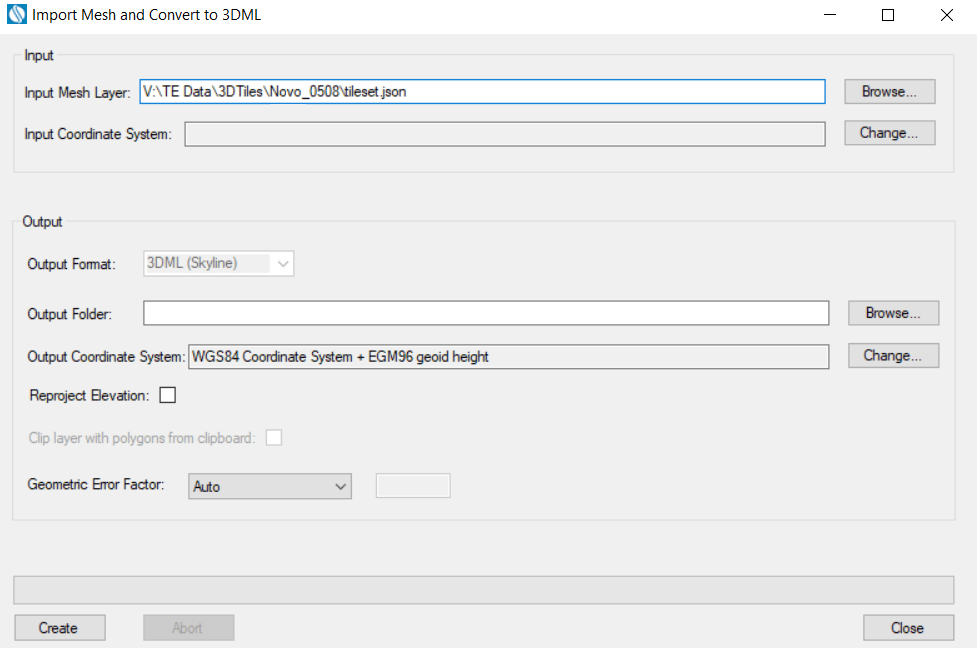Importing and Converting OGC 3D Tiles (tileset.json) Layers
3D Tiles mesh layers can be imported and converted to the stream optimized, 3DML mesh layer format. See “Uploading Layers to SkylineGlobe Server” in the “Working with SkylineGlobe Server” chapter.
To import and convert a 3D Tiles mesh layer:
1. On the Layers tab, in the 3D Mesh group, click the arrow next to Load 3D Mesh, and select Import 3D Tiles Layer.
The Import Mesh and Convert to 3DML dialog is displayed.
2. Browse to the 3D Tiles layer you want to import, and click Open. The Import Mesh and Convert to 3DML dialog is displayed.

Import Mesh and Convert to 3DML
3. The Input Mesh Layer is populated based on the 3D Tiles layer selected in the previous step and the mesh model’s Input and Output Coordinate Systems are automatically set to ECEF.
4. Browse to the required Output Folder. The converted mesh model will be saved to this folder.
5. If you want to reproject the input layer’s elevation values to the output coordinate system, select the Reproject Elevation check box. Most 3D Tiles use ellipsoid elevation as required by the Cesium 3D Tiles standard, so it is recommended to reproject them to the vertical coordinate system of the terrain.
Note: Some 3D Tiles are created by reprojecting geoid elevation values declared as ellipsoid, into Earth-Centered, Earth-Fixed (ECEF). These 3D Tiles do not adhere to the 3D Tiles standard of the ellipsoidal WGS 84 ECEF reference frame (EPSG 4978) coordinate system and will only match other resources, e.g., data from terrain providers that use such ellipsoid-declared geoid values. To convert such 3D Tiles to ellipsoid-declared 3DML with correct geoid values, select WGS84 Lat-Long ellipsoid (4326) as the output, and select the Reproject Elevation check box. After the import process is complete, open these 3DML’s property sheets and clear their Reproject Elevation check boxes, so their geoid values are not reprojected.
After completing the import process, you can further convert the 3DML to geoid-declared mesh layers (with geoid values): by exporting the 3DML to 3DML format using the Export to Mesh tool. Set both the Input and Output Coordinate Systems to WGS84 Coordinate System + EGM96 geoid height, and select Reproject Elevation, to override the elevation coordinate system that was previously declared incorrectly.
6. If you want to import sections of the mesh layer using clip polygons on the clipboard, select the Clip layer with polygons from clipboard check box.
Note: Only objects with a polygon geometry, i.e., created via 2D Objects > Polygon (on the Home or Objects tab) or polygons in a feature layer are supported.
7. A correction factor sometimes must be applied to a layer’s geometric error value so that the 3DML will display properly in TerraExplorer. Geometric error together with other properties allow the viewer to determine the optimal balance between quality and performance so that the best Level of Detail (LOD) for the current view can be used. Select Auto to automatically calculate the factor for optimal display in TerraExplorer.
8. Click Create. The created 3DML is added to the project and displayed in the Project Tree.